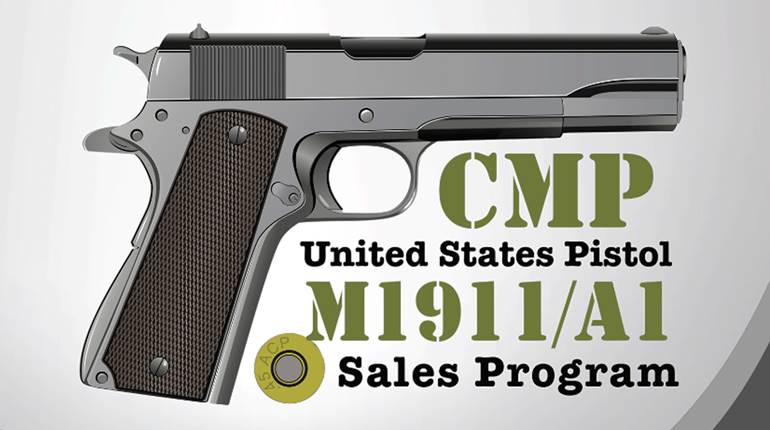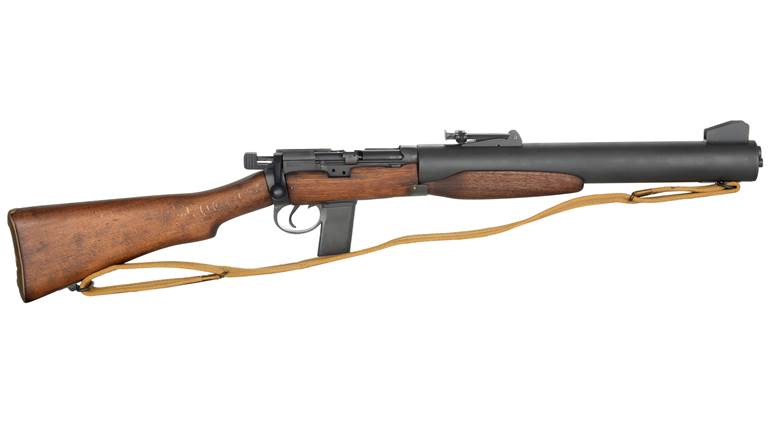
Conceived in the fertile mind of John Moses Browning, the .45 ACP U.S. Model of 1911 was the culmination of extensive testing around the turn of the 20th century to develop a military handgun to replace the still-potent, but hopelessly obsolete, Model 1873 SAA and its replacement, the anemic .38 Colt double-action revolver. Immediately upon its introduction into service, the new pistol was apparently something special.
This was evident in World War I when a large number of Doughboys arrived in France armed with .45 pistols along with their M1903 or M1917 service rifles. The potent short-range stopping power of the rugged and reliable M1911 proved its worth in many brutal close-quarter trench-warfare engagements. After the war, many .45s went home in the duffel bags of members of the American Expeditionary Force. Although it performed superbly in the woefully misnamed “War to End All Wars,” some changes were recommended, including slight modifications of the sights, frame, trigger, hammer and mainspring housing.
By 1926 these various modifications were instituted, which resulted in the newly updated pistol’s nomenclature being changed to “M1911A1.” A May 17, 1926, Ordnance Dept. directive stated: “[A]s a means of ready distinction between the two models, it is agreed that all pistols bearing serial numbers under 700,000 should be designated as 1911 pistols, while pistols beginning at 700,000 should be designated M1911A1 pistols.” Even after standardization of the new variant, there were ample numbers of M1911s in the government’s inventory to meet the rather limited demands of our pared-down military between the wars, and Colt did not begin quantity production of the revamped M1911A1 until 1937.
As it became apparent to all but the most myopic observer that the United States was being inexorably drawn into World War II, demand for all manner of military arms, including pistols, increased dramatically. As Colt began to ramp up production of the M1911A1, the Ordnance Dept. made plans for a number of other commercial firms to manufacture the pistol as well. For example, in 1939 the well-known maker of sewing machines, the Singer Manufacturing Co., received a “Production Study” contract to develop a manufacturing program for the M1911A1. This was followed on April 17, 1940 by an “Educational Order” contract for 500 M1911A1s. The pistols made by Singer were serially numbered in the S800001 to S800500 range. It was eventually determined that the company could better serve the war effort by concentrating on manufacturing other military equipment. Thus, Singer did not produce any additional .45s for the government beyond the 500 made under the Educational Order.
After Pearl Harbor, the already high demand increased exponentially. On March 16, 1942, the Remington Rand Co. received a government contract for the production of 125,000 M1911A1 pistols to be made at the firm’s Syracuse, New York facility. Some of the machinery and tooling used by Singer to fabricate the 500 Educational Order pistols was sent to Remington Rand. To speed production, the company obtained a number of components from various sources, including Colt, Springfield Armory and High Standard Arms Co. The first Remington Rand pistols were delivered to the government in November 1942. However, production was temporarily halted in March 1943 to correct problems encountered regarding the non-interchangeability of parts. This was eventually corrected and Remington Rand received additional contracts and continued turning out .45 pistols until the end of World War II. The firm made almost 900,000 M1911A1 pistols at the lowest per-unit cost of all the manufacturers.
On May 5, 1942, the Swissvale, Pa., firm of Union Switch & Signal was granted a contract for the manufacture of 200,000 M1911A1s. The firm delivered its first pistols in March 1943, but US&S was unexpectedly informed that its contract would be reduced to just 30,000 so the firm could concentrate instead on the production of M1 carbine parts. Just before these pistols were completed, however, the government ordered an additional 25,000 M1911A1s. Union Switch & Signal completed the last of the 55,000 pistols on Nov. 27, 1943.
In December 1942, the Ithaca Gun Co. began production of M1911A1 pistols. Other than Colt, Ithaca was the only firm that had previously manufactured firearms prior to receiving a contract to produce M1911A1s. As was the case with some of the other manufacturers, Ithaca received a number of components from various sources to expedite production of the pistols. The firm also redesigned some of the parts, such as the trigger and hammer, to speed production and reduce cost. Ithaca manufactured a total of 335,466 M1911A1s.
In addition to the new production guns made by the above firms, large numbers of existing M1911 pistols were issued during World War II. Since the guns had been in service for almost a quarter century, many required refurbishment or overhaul.
The .45 pistol saw widespread service in all theaters of the war and further cemented its already stellar reputation as one of the finest military handguns of all time. The pistol was often criticized for being heavy and, like most handguns, required training and practice to be reasonably proficient while shooting at anything much beyond point-blank range. Regardless, the .45 was reliable and possessed potent short-range “stopping power.” One example of this occurred during an incident on Guadalcanal: “There was a moment of heart-stopping drama at the division [command post] when a sword-wielding Japanese officer stepped into the open with two riflemen and headed directly for Archer Vandegrift, who was in the open, alone and unarmed. Master Gunnery Sergeant Sheffield Banta, an utterly unflappable old salt, stopped typing a report long enough to unholster his .45-caliber automatic pistol and plug the officer dead in his tracks.”
Despite such instances, a handgun was essentially a supplemental sidearm and was generally employed in actual combat action only when the more effective rifles and automatic arms were unavailable, out of ammunition or damaged. An Oct. 23, 1943, Marine Corps document titled “Report on Infantry Weapons in Combat” gave a brief synopsis of the various arms used by a Marine Raider Battalion on New Georgia Island. The section pertaining to the .45 simply stated: “U.S. Pistol, Cal. .45, M1911-M1911A1. Held up very well, but used very little.”
Many .45 pistols were acquired by troops who were not officially authorized to be issued them as called for in their unit’s TOE (Table of Organization and Equipment). However, such regulations were rarely enforced in combat zones, and many G.I.s and Marines who could acquire a .45 did so, and considered themselves lucky.
A leather hip holster, the Model of 1912, was standardized soon after the M1911’s adoption. This holster had a swivel attachment to make it better adapted to cavalry use. Just before America’s entry into World War I, the Model of 1916 holster was adopted, which differed from the M1912 primarily in the deletion of the swivel feature. Both were fitted with wire hooks that attached to the grommets on the bottom of the standard webbed pistol belt or cartridge belt. There were sufficient numbers of World War I-vintage M1916 holsters to meet the demand until the U.S. became actively involved in World War II. The M1916 holster was put back into production and almost 3 million were made by 18 different commercial firms between 1941 and 1945. These holsters were embossed with a large “U.S.” on the cover flap, with the name of the maker and year of production on back.
A leather shoulder holster for the .45 pistol, designated as the “M3,” was adopted in 1942 for use by aviators, tankers and others who preferred carrying the pistol over the hip holster. An improved shoulder holster design was standardized in 1944 as the M7. The pistol was secured in the shoulder holster by means of leather strap with a snap fastener. The shoulder holsters were also embossed with a large “U.S” on the front, with the identity of the manufacturer and year of production on the back.
Extra seven-round magazines were typically carried in a two-pocket canvas pouch. The first pattern was coincidentally the Model 1912, which was made and issued in large numbers during World War I. It was characterized by having two “lift-the-dot” fasteners on the cover flap. The date of production, most commonly 1918, was marked inside the flap. Prior to World War II, the Model 1923 pouch was standardized, which differed from its predecessor in having only a single snap fastener on the cover flap. A large “US” was stenciled in black on front of the flap. Both types had a snap on the back of the pouch that mated with a corresponding fastener on the standard pistol belt to keep the pouch from shifting while attached. Few of these later pouches were made prior to World War II, but large numbers were procured from 1941 to 1945. Both M1912 and M1923 magazine pouches were widely issued during World War II.
While the M1 Carbine was developed in 1941 primarily as a replacement for the M1911 and M1911A1, the carbine never totally replaced the handgun in service. It was not uncommon for soldiers and Marines to be armed with both carbines and .45 pistols. Nevertheless, the desire to replace the pistol with the carbine continued throughout the war. This was evidenced in a Jan. 26, 1943, Marine Corps document stating: “That a policy be established of gradually replacing all .45 caliber pistols … in the Fleet Marine Force with M1 carbines or M1 rifles in that order of preference and with priority to new organizations … .” The report continued with the blunt statement, “Practically all officers seem to be in favor of getting rid of the pistol … .” and concluded with the recommendation that “… additional pistols be procured only to meet current needs if and when sufficient pistols are not released by the issue of carbines to fill requirements.”
Despite this official stance, pistols were issued in ever-increasing numbers during the war. As an example, the U.S. Marine Corps’ TOE in 1942 authorized 798 .45 pistols for a Division but, by 1945, the authorized figure had been increased to 1,707. So much for efforts to get rid of the pistol. The situation was much the same in the U.S. Army where the carbines and .45s were procured and issued side by side in large numbers. The total number of M1911A1 pistols manufactured during World War II was 1,878,742. Clearly, the .45 was an integral part of America’s World War II infantry small arms arsenal.






































